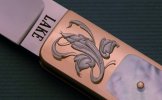zzcutter
Elite Cafe Member
Hello
I was wondering if anyone here has had issues with 24kt gold turning to a rose gold color when having a Nitrite process done too it in a firearm.
And any idea what could have caused this to happen.
Thanks J
I was wondering if anyone here has had issues with 24kt gold turning to a rose gold color when having a Nitrite process done too it in a firearm.
And any idea what could have caused this to happen.
Thanks J







